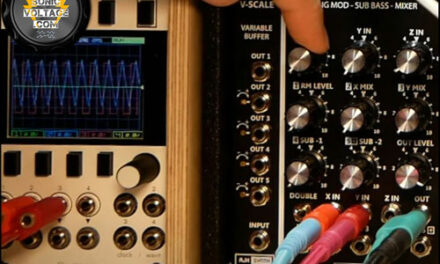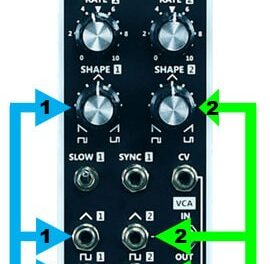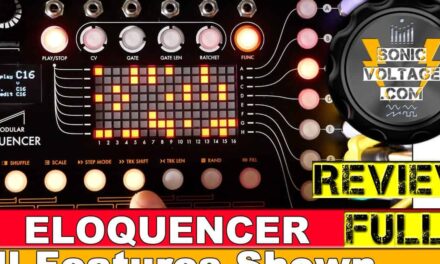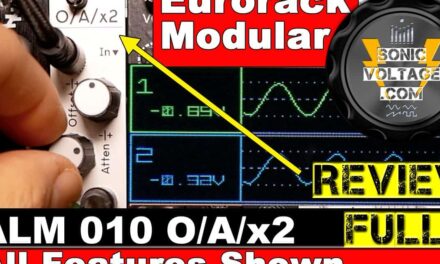
AJH Synth SONIC XV Eurorack Module Review
Is there anything special about the AJH Synth SONIC XV Diode Ladder Wave Filter?
The world of Eurorack Modular Synthesisers is gifted with a wide range of unique-sounding eurorack filter modules, some based on the design and circuitry of filter sections of classic vintage analogue synths, some offer multiple modes e.g. band-pass, low-pass and high-pass filter modes all available on a single eurorack module
Generally, most filters limit their functionality to filtering out harmonic content, a range of frequencies, from the original sound source.
AJH SYNTH came up with something rather unique for the Sonic XV and the hint is in the module sub-title, Diode Ladder Wave Filter. Can you spot the hint?
Let’s start from the pure filter section which is a Four-Pole (24dB) Diode Ladder Filter based on the circuitry design found on the vintage Musonics Sonic V synth from the 70s. The Sonic V synth was designed by an ex-Moog employee while he worked at Musonics, eventually, Musonics bought RA Moog and released the Moog Musonics Sonic VI.
The AJH SYNTH SONIC XV has a very nicely featured filter section which includes
Control Knob (FREQ) for Frequency Cut Off
CV-Control Input (FREQ-CV) for Frequency Cut Off
CV Input Attenuator (FREQ CV knob)
Control Knob (RES) for Resonance
CV-Control Input (RES-CV) for Resonance
Resonance CV Attenuator (RES knob when a signal is present at RES-CV input)
A 1V/Oct input to control the pitch when the filter goes into self-oscillation.
Naturally, there is an input for your source signal
Input Level control (IN LEVEL Knob)
The Sonic XV module offers a multimode filter output section with 3 output types, all available at the same time. We can find:
A 4-pole (24dB) output
A 1-pole (6dB) output
A Band Pass output.

So far we can see that this is surely a perfectly competent and versatile filter and although it will sound unique, there are other filters inspired by other classic designs and it is down to personal preference to decide if the character of this filter is the one you want over the character of another filter. AJH Synth themselves, for example, offer another classic filter module, the Mini Mod Transistor Ladder Filter which recreates the original Model D Filter and adds a few nice touches to it. But…
…what makes this Sonic XV module a bit special when compared to other more standard filter modules is that AJH SYNTH added not one but two Wafefolders!
In addition to the filter section, the SONIC XV also offers
a wave folder that is applied to the input signal
a wave folder that is applied to the resonance loop!
This means the SONIC XV is a very intriguing and powerful sound processor!
With the filter section, you can cut out a range of frequencies (harmonic content) from the input signal, and you can do so with 6dB or 24dB Low Pass modes or with the Band Pass mode (all available at the same time).
and/or you can add wave-folding to the input signal and create/add harmonic content (instead of removing it) to the input signal
and/or you can further enrich the sound by adding wave-folding to the resonance loop
In practice, you could start with a wave that has low harmonic content, (sine, triangle), then add harmonic content to it creating a new and original richer sound. Of course, you can still filter the sound via the filter section.
AJH Synth Sonic XV: Waveshapers
For each of the two wave-shaping sections of the module, we have CV Control Input, Wet/Dry control mix knob and Drive Amount control knob
Input Waveshaper
We have control over the ‘drive’ amount applied to the Input Waveshaper (IN WAVE knob) and wet/dry control knob (IN MIX knob) to change the proportion between the clean input signal and the wave-shaped signal sent to the module’s output.
IW-CV
The IW-CV is the input for the control voltage signal over the ‘drive’ amount sent to the Input Waveshaper. If a voltage is present at the IW-CV then the IN WAVE knob will function as the attenuator for the IW-CV voltage control signal.
IW-V Switch
There is also an IW-V switch, which is a 3-way switch that changes the character of the final sound produced by the Input Waveshaper.
Resonance Waveshaper
We have control over the ‘drive’ amount applied to the resonance loop waveshaper (RES WAVE knob), and wet/dry control knob (RES MIX knob) to change the proportion between clean resonance and wave-shaped resonance present at the module’s output. The RW-CV is the resonance wave-shaper Control Voltage input which gives us control over the Drive amount applied to the Resonance Waveshaper. If we send a voltage signal to the RW-CV input then the RES WAVE knob will work as an attenuator for the RW-CV voltage control signal.
Filter And Resonance
The SONIC XV eliminates ‘the drop’ in the level you would normally get when increasing resonance over a 24dB filter mode. It does so by implementing a level correction circuit, and as you can hear in the video, it works rather well.
Filter Selft Oscillation – Extended With Wave Folding
With Resonance at maximum (self-oscillation) and the Frequency knob set high, we can hear the sound of self-oscillation. Turning down the Frequency knob, as we go lower than the 7 mark, we won’t be able to hear anything anymore, and this would be a typical range available on self-oscillating filters.
With the Sonic XV, if we increase the RES Wave folder level and the Res Mix, we can extend the range over which we can have usable self-oscillation. We can now lower the Frequency knob way past the 7 mark and still have a sound we could then apply pitch control to with the 1V/Oct input.
It’s a given that by adding wavefolding we won’t be hearing a pure sine, but we will have a sound we can pitch and play with.
Waveshapers On A Triangle Wave
Input Waveshaper on a Triangle Wave Input – In this image, you can see a section of the harmonic content of the Triangle present at the input (and output) of the filter, without any wave shaping applied.
In this image, we have the same triangle input but this time we are looking at the output of a wet mix coming out of the Sonic XV which contains the original Triangle plus applied WaveShaping additional harmonic content
Watch the video from 19:30 minutes to see and hear the effect of the Input Waveshaper and Drive on the Triangle wave present at the input of the module.


Resonance Waveshaper On A Triangle Wave Input
First, we need to add some Resonance because the Resonance Waveshaper only works on the Resonance.
Follow the video from 22:50 as we set the RES WAVE level to maximum then we gradually move from Dry Mix (first image) to Wet Mix (second image).
You can play around with the FREQuency knob and Resonance to change where (in terms of Frequency) we apply Resonance and Resonance Waveshaping to obtain sound variations.
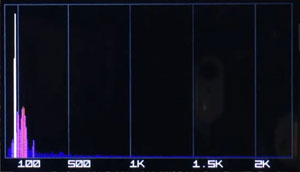

Triangle In… Look At The Wave Shape Present At The Output
The first image is the Triangle without processing
Second Image: we mixed some amount of Input Wave Shaper into the signal.
Third Image: More Input Wave Shape added into the mix.
Then with the Resonance Waveshaper (from 27:17m in the video)
Watch the video to see and hear the results of adding different amounts of processing to the Triangle wave.
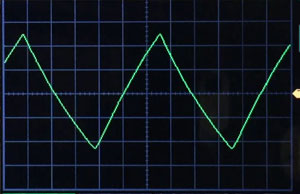
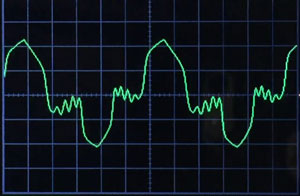
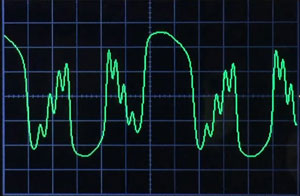
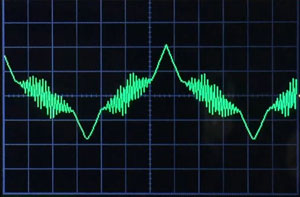
IW-V
A three-position switch to select between three bias variations for the Input Waveshaping. The bottom position has more low-end content for example.
Sonic XV: CV Control Inputs
The AJH Synth Sonic XV offers 4 CV control inputs, which is nice. All four CV inputs can cope with up to +-10V signals, but the useful range is 5 Volts
FREQ CV: Bipolar +- 5V
RES-CV: Unipolar 0-5 Volts
RW-CV: Unipolar 0-5 Volt
IW-CV: Unipolar 0-5 Volt
(31:29 m) We progress with applying Voltage (LFO signals in this specific case) to the CV inputs and hear the effect of CV control over the processed sound. CV Fun. WATCH THE VIDEO: CV Control Section
AJH Synth SONIC XV: Conclusion
I have to say I am in love with this filter. It has a specific uniquely different character but that’s just the start. A nice multi-output diode ladder filter with the addition of two waveshapers:
- A Waveshaper you can apply to the input sound
- A Waveshaper you can apply just to the resonance
The Sonic XV offers plenty of sonic variety as an audio processing module.
Control over Wet/Dry amount of wave shaping, different amounts for each wave shaper, change resonance and Frequency values, play around with CV control… a lot of fun can be had.
From ‘scratching’ sounds to more ‘plastic/wet’ (maybe) sounds… it is a very capable 14Hp module with 4 CV inputs.
14HP
24mm Deep
34mm Deep (Inc Power Connector)
For a more practical look a the AJH Synth Module please watch the AJH Synth SONIC XV Video Review and remember to SUBSCRIBE to SonicVoltage Eurorack Modular YouTube Channel, more videos are coming.
If you find this post useful I would appreciate it if you could SHARE it (Forums, Facebook, Twitter, Instagram, etc…). It would help me a lot. And sharing will also tell me these reviews are being of some use to the readers which in turn pushes me to produce more reviews. Feel free to comment, ask questions below or leave comments under the video review and Subscribe to SonicVoltage YouTube Channel, I’ll do my best to reply.
Ok, people! Thank you for stopping by and/or watching the video review.
Until next time… Happy Euroracking, Have Fun!


